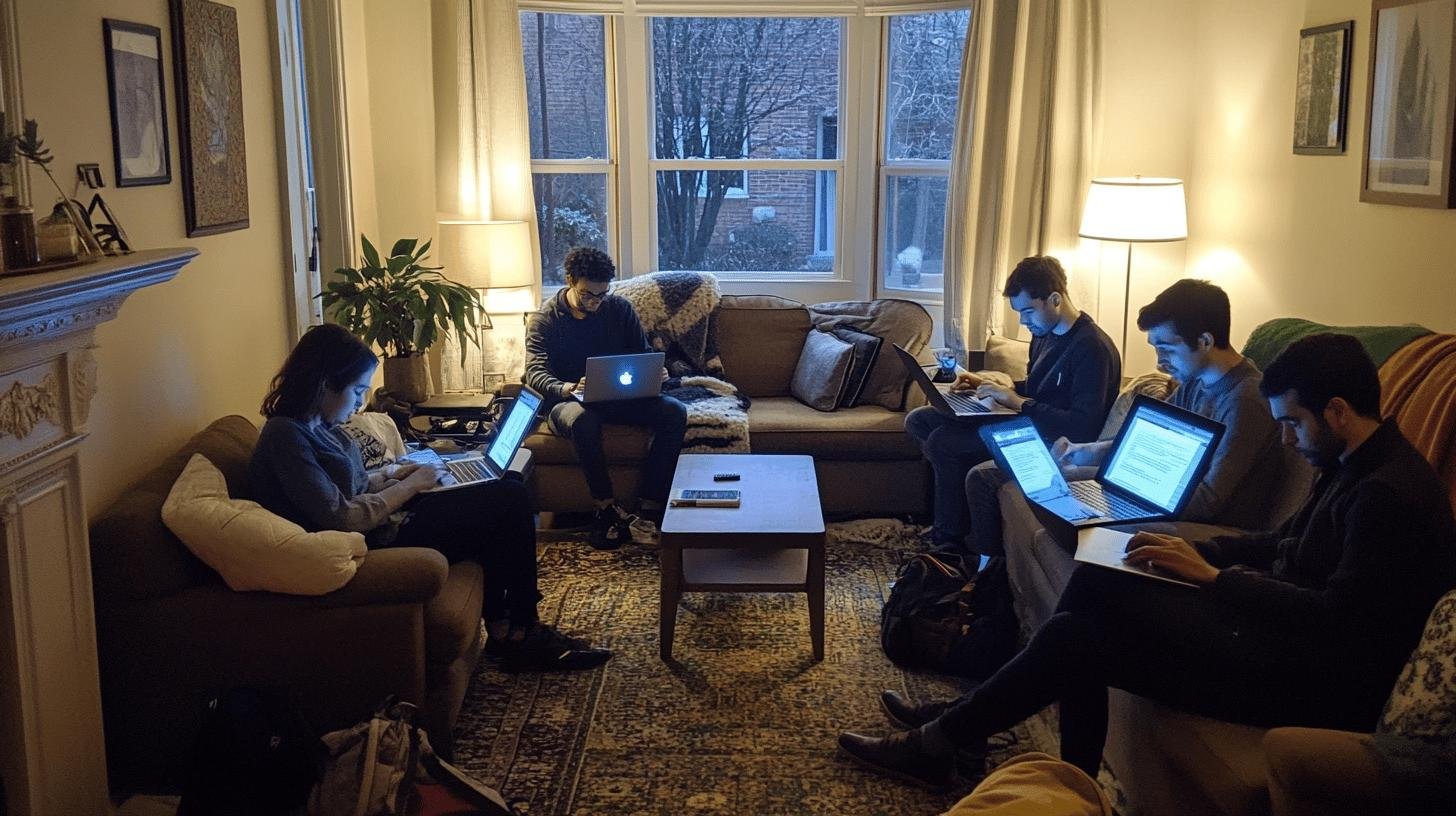TL;DR:
- Industrial Revolution: Long hours, harsh conditions, and minimal personal time.
- Late 20th Century: Feminist and mental health movements advocate for work-life flexibility.
- 21st Century: Technology facilitates remote work, blurring work-life boundaries.
- Key Workplace Policies: Paid parental leave, flexible hours, remote work, wellness programs.
- COVID-19 Impact: Increased stress from remote work and blurred personal-professional lines.
- Burnout: Heightened by constant connectivity, linking to mental health awareness.
- Future Trends: Blending personal hobbies with work, adopting flexible schedules, and enhancing wellness initiatives to improve employee satisfaction and balance.
Ever felt like you’re constantly juggling work and personal life without catching a break? You’re not alone. Work-life balance has taken quite the rollercoaster ride through history. Back in the Industrial Revolution, long hours were the norm, leaving little room for anything else.
Fast forward to the late 20th century, where cultural shifts started pushing for change. Our understanding of work-life balance has evolved, shaped by technology and policy changes.
Dive into this article to trace how balance between work and life has transformed and what’s driving its ongoing evolution.
Historical Shifts in Work-Life Balance
How did the Industrial Revolution impact work-life balance?
During the Industrial Revolution, factories rapidly expanded, focusing on maximizing output. Workers faced long hours in harsh conditions, with little regard for personal time or well-being. Work-life balance was nearly nonexistent as economic growth and increased productivity were the primary goals.
What cultural changes in the late 20th Century affected work-life balance?
The late 20th Century saw shifts in balancing work and personal life. Feminist thought challenged traditional gender roles, advocating for equal opportunities and more flexible working conditions. Additionally, an increased awareness of mental health highlighted the need for balance supporting both career and personal well-being. These cultural changes began reshaping workplace norms, promoting policies accommodating family life and personal needs.
Key Historical Milestones in Work-Life Balance Progression:
- Industrial Revolution (Late 18th to 19th Century): Focus on long hours and high productivity with little personal time.
- Early to Mid-20th Century: Labor movements push for regulated work hours and weekends off.
- Late 20th Century: Feminist movements and mental health awareness advocate for flexibility and equality.
- 21st Century Onset: Introduction of technology influences remote working and flexible schedules.
- Post-2000s: Increased focus on employee well-being and sustainable work practices.
These milestones reflect the ongoing journey towards achieving a healthier balance between work and personal life.
Technological Influences on Work-Life Balance

How have smartphones and digital communication tools affected work-life balance?
With smartphones, especially since the iPhone’s debut in 2007, work-life balance has shifted. Employees can access work emails and tasks from anywhere, creating an always-on work culture. The line between work and personal life blurs, as notifications can interrupt personal time.
What role has telecommuting played in altering work-life balance?
Advances in technology have made telecommuting viable for many workers. Working from home or anywhere else offers greater flexibility in managing time. However, this flexibility can blur the boundary between work and personal life, with homes becoming both living and working spaces.
Technological Advancements and Impact on Work-Life Balance:
| Technological Advancement | Impact on Work-Life Balance |
|---|---|
| Smartphones | Always-on culture, blurred boundaries between work and life |
| Digital Communication Tools | Increased connectivity, more flexible work hours |
| Telecommuting | Flexibility in work location, challenges in time management |
| Cloud Computing | Access to work resources anytime, anywhere |
| Video Conferencing | Remote meetings, reduced need for physical presence |
Technological shifts have redefined employee interaction with work, requiring careful management to prevent overwork and protect personal time.
The Role of Workplace Policies in Work-Life Balance
How do family leave policies and flexible working hours support work-life balance?
Family leave policies and flexible hours are key to supporting work-life balance. They allow employees to manage personal responsibilities, such as childcare, without added stress from rigid schedules. Paid parental leave, for instance, gives new parents time to bond with their newborns. Flexible hours let individuals tailor work schedules to fit their lives better, reducing stress in balancing work and family.
How do these workplace policies align with the evolving needs of employees?
Today’s workforce values careers that don’t compromise personal well-being. This shift is fueled by recognition of the importance of mental health and personal satisfaction. Employees seek roles offering financial rewards and respecting the need for family and personal time. By adopting policies like flexible hours and family leave, companies align with these desires, attracting talent who prioritize work-life balance.
Notable Workplace Policies Enhancing Work-Life Balance:
- Paid parental leave
- Flexible working hours
- Remote work options
- Job-sharing arrangements
- Employee wellness programs
- On-site childcare facilities
These policies reflect a broader commitment to fostering environments where employees can thrive both professionally and personally.
Modern Challenges and Opportunities in Work-Life Balance

How did the COVID-19 pandemic affect work routines?
The COVID-19 pandemic forced many to shift to remote work, blurring home and office lines. Routines were upended, creating environments where individuals juggled work, family, and personal responsibilities in the same space. This led to increased stress as people struggled to maintain productivity while managing household distractions and uncertainties.
What is the link between burnout and mental health awareness?
Burnout, worsened by remote work demands and constant connectivity, has become prevalent. Employees facing burnout experience exhaustion, reduced performance, and detachment. This has brought mental health awareness to the forefront, emphasizing organizational prioritization of employee well-being. Addressing mental health can mitigate burnout, leading to more satisfied and productive employees.
Strategies for Overcoming Modern Work-Life Balance Challenges:
- Set clear boundaries between work and personal time
- Prioritize tasks to focus on essentials
- Schedule regular breaks to recharge and prevent fatigue
- Use technology to streamline communication and reduce overload
- Encourage open dialogue about mental health and well-being
These strategies help individuals navigate modern work environments, fostering balance that nurtures both professional success and personal fulfillment.
Future Predictions for Work-Life Balance
How will integrating personal hobbies with professional life affect work-life balance?
In the future, work-life balance will involve blending personal interests with professional roles. Employees will integrate hobbies into their work, allowing engagement in passions during work hours. This boosts job satisfaction, creativity, and motivation, as individuals find more meaning in their daily tasks.
What role do organizations play in fostering supportive environments?
Organizations shape the future of work-life balance by adopting flexible schedules and cultivating supportive cultures. Offering options like flexible hours, remote work, and wellness programs accommodates diverse needs. A supportive culture encourages open communication and prioritizes employee well-being, helping workers manage personal and professional lives effectively.
Future Trends Impacting Work-Life Balance:
| Future Trend | Potential Impact on Work-Life Balance |
|---|---|
| Integration of personal hobbies with work | Increased job satisfaction and motivation |
| Implementation of flexible work schedules | Better time management and reduced stress |
| Emphasis on wellness initiatives | Improved mental and physical health |
| Rise of digital transformation tools | Enhanced productivity and remote work capabilities |
| Development of supportive workplace cultures | Greater employee engagement and retention |
These trends highlight a shift towards a holistic approach to work-life balance, integrating personal fulfillment and professional success into a cohesive lifestyle.
Final Words
Understanding the evolution of work-life balance over time helps one appreciate the journey toward better living conditions.
From the grueling work hours of the Industrial Revolution to today’s digital influences, each era has reshaped the meaning of balance.
Technological advancements and progressive workplace policies have paved the way for more flexible opportunities, while modern challenges like the COVID-19 pandemic emphasize the need for continuous adaptation.
Looking ahead, the integration of personal interests with work presents a promising outlook. Embracing these changes can lead to improved well-being and satisfaction.
FAQ
How has work-life balance changed over the years?
Work-life balance has evolved from long, grueling work hours during the Industrial Revolution to more flexible scheduling and awareness today. Cultural shifts in the late 20th Century promoted balance as critical for mental health.
What is the development of work-life balance?
The development of work-life balance includes a shift from maximizing work output to valuing employee wellness and flexibility. Increased awareness of mental health and gender equality have driven these changes.
What is the new work-life balance?
The new work-life balance focuses on career-life integration, allowing professionals to blend personal interests with work responsibilities. Flexible schedules, remote work, and mindfulness programs are becoming staples.
What’s the new term for work-life balance?
The new term for work-life balance is often referred to as “career-life integration.” It emphasizes blending personal interests and professional duties rather than strictly separating them.
